View in other NatureServe Network Field Guides
NatureServe
Montana
Utah
Wyoming
Idaho
Wisconsin
British Columbia
South Carolina
Yukon
California
New York
Horned Clubtail - Arigomphus cornutus
State Rank Reason (see State Rank above)
The Horned Clubtail dragonfly is currently listed as an "S2S4" species of potential concern in Montana because they are potentially at risk because of limited and/or declining numbers, range and/or habitat, even though it may be abundant in some areas. This rank is based on limited collections, but is probably more widespread that the rank implies.
General Description
We do not yet have descriptive information on this species. Please try the buttons above to search for information from other sources.
Species Range
Montana Range
Range Descriptions
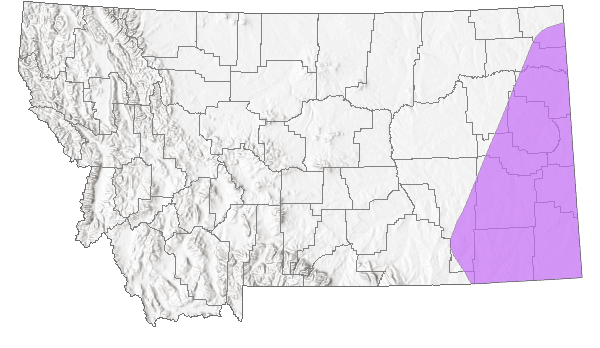
 Native
Native
Range Comments
Recently collected from Otter Creek and Wolf Creek in SE and NE Montana (Stagliano 2012); previously, only known from man-made reservoirs in southeastern Montana, such as Rush Hall Lake, north of Baker (Fallon County), and MacNab Pond, near Ekalaka (Carter County) (Miller and Gustafson 1996).
Observations in Montana Natural Heritage Program Database
Number of Observations: 13
(Click on the following maps and charts to see full sized version)
Map Help and Descriptions
Relative Density
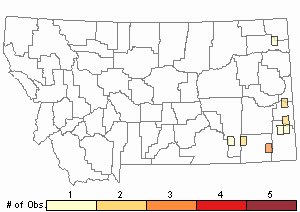
Recency

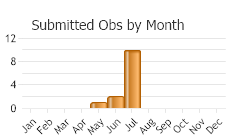
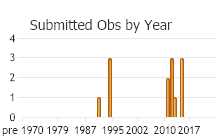
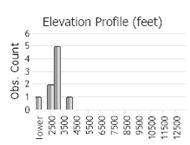 (Observations spanning multiple months or years are excluded from time charts)
(Observations spanning multiple months or years are excluded from time charts)
Habitat
The preferred habitat of the Horned Clubtail is permanent slow streams and rivers with vegetated edges as well as ponds and lakes (Dunkle 2000, Paulson 2009). In Montana, this species has so far only been collected from man-made reservoirs (Miller and Gustafson 1996). The Horned Clubtail also uses open meadows and woodlands away from water to forage and roost (Dunkle 2000).
National Vegetation Classification System Groups Associated with this Species
Wetland and Riparian
Alkaline - Saline Wetlands
Peatland
Riparian and Wetland Forest
Riparian Shrubland
Wet Meadow and Marsh
Food Habits
Larvae feed on a wide variety of aquatic insects, such as mosquito larvae, other aquatic fly larvae, mayfly larvae, and freshwater shrimp.
Adult- This damselfly will eat almost any soft-bodied flying insect including mosquitoes, flies, small moths, mayflies, and flying ants or termites.
Reproductive Characteristics
Male Horned Clubtails perch on the ground, on rocks or on lily pads near the shoreline and patrol along the shore or over the water. When disturbed, they fly into nearby uplands where the females tend to spend most of their time perched on leaves (Dunkle 2000, Paulson 2009).
Stewardship Responsibility
References
- Literature Cited AboveLegend:
 View Online Publication
View Online Publication Miller, K.B. and D.L. Gustafson. 1996. Distribution records of the Odonata of Montana. Bulletin of American Odonatology 3(4):75-88.
Miller, K.B. and D.L. Gustafson. 1996. Distribution records of the Odonata of Montana. Bulletin of American Odonatology 3(4):75-88. Stagliano, D.M. 2012. Aquatic Surveys and Re-assessment of Sites within the Middle Powder River Watershed. Report for the U.S. Bureau of Land Management, Miles City Field Office and The Interagency BLM Aquatic Task Group. Montana Natural Heritage Program, Helena, Montana. 19 pp. plus appendices.
Stagliano, D.M. 2012. Aquatic Surveys and Re-assessment of Sites within the Middle Powder River Watershed. Report for the U.S. Bureau of Land Management, Miles City Field Office and The Interagency BLM Aquatic Task Group. Montana Natural Heritage Program, Helena, Montana. 19 pp. plus appendices.
- Additional ReferencesLegend:
 View Online Publication
View Online Publication
Do you know of a citation we're missing? Dunkle, S.W. 2000. Dragonflies through binoculars: A field guide to dragonflies of North America. New York, NY. Oxford University Press. 266 pp.
Dunkle, S.W. 2000. Dragonflies through binoculars: A field guide to dragonflies of North America. New York, NY. Oxford University Press. 266 pp. Hendricks, P., S. Lenard, D.M. Stagliano, and B.A. Maxell. 2013. Baseline nongame wildlife surveys on the Fort Peck Indian Reservation. Report to the Assiniboine and Sioux Tribes of the Fort Peck Indian Reservation. Montana Natural Heritage Program, Helena, MT. 83 p.
Hendricks, P., S. Lenard, D.M. Stagliano, and B.A. Maxell. 2013. Baseline nongame wildlife surveys on the Fort Peck Indian Reservation. Report to the Assiniboine and Sioux Tribes of the Fort Peck Indian Reservation. Montana Natural Heritage Program, Helena, MT. 83 p. Miller, G. S., Jr. 1896. Genera and subgenera of voles and lemmings. N. Amer. Fauna 12. 84 pp.
Miller, G. S., Jr. 1896. Genera and subgenera of voles and lemmings. N. Amer. Fauna 12. 84 pp. Paulson, D.R. 2009. Dragonflies and Damselflies of the West. Princeton University Press, Princeton. 535 pp.
Paulson, D.R. 2009. Dragonflies and Damselflies of the West. Princeton University Press, Princeton. 535 pp.
- Web Search Engines for Articles on "Horned Clubtail"
- Additional Sources of Information Related to "Insects"





